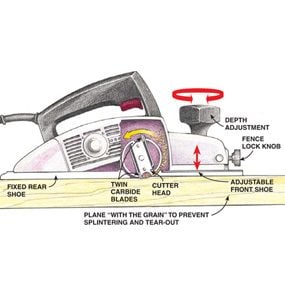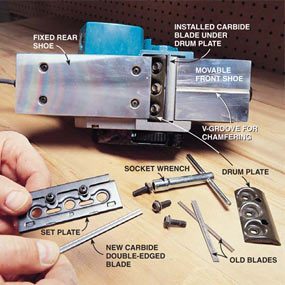Do you ever wonder how electric hand planers work? Well, get ready to learn! In this article, we’ll explore the fascinating world of electric hand planers and uncover the secrets behind their functionality. So, if you’re curious to know how these powerful tools shape and smooth wood, you’re in the right place!
You may have seen electric hand planers in action or heard about their wood-shaping wizardry. But have you ever wondered how they actually work their magic? Don’t worry, we’ve got you covered! In this article, we’ll dive into the inner workings of electric hand planers and reveal the mechanisms behind their incredible performance.
Have you ever wanted to know the nuts and bolts of electric hand planers? Look no further! In this article, we’ll unravel the mystery and explain how these versatile tools operate. So, if you’ve ever marveled at the smooth surfaces they create or wondered about the powerful motor that drives them, stick around and find out how electric hand planers work!
How Do Electric Hand Planers Work?
Electric hand planers are versatile tools used for shaping and smoothing wood surfaces. They are commonly used by woodworkers, carpenters, and DIY enthusiasts. If you’re curious about how these powerful tools operate, this article will provide a detailed breakdown of their inner workings and explain how they help create precise and smooth finishes on wood.
1. Understanding the Components
At its core, an electric hand planer consists of several essential components that work together to achieve the desired result. The main components include:
1. Motor: This is the heart of the tool and provides the power needed to drive the cutting blade.
2. Cutterhead: The cutterhead is fitted with blades that rotate rapidly to remove thin layers of wood. These blades can be easily adjusted to control the depth of the cut.
3. Depth Adjustment Knob: This knob allows users to adjust the depth setting of the cutterhead.
4. Chip Ejection Port: As the blades cut through the wood, the chips are expelled through this port to ensure a clean working area.
2. Power Source
Electric hand planers are typically powered by electricity, either from a corded source or a rechargeable battery. Corded models provide a consistent power supply, making them suitable for longer projects. On the other hand, cordless models offer more mobility and convenience, but their operating time is limited by the battery life. Regardless of the power source, both types of planers are designed to deliver sufficient power to handle most woodworking tasks.
3. Cutting Mechanism
The cutting mechanism of an electric hand planer is where the magic happens. As the motor powers the rotation of the cutterhead, the blades make contact with the wood surface and gradually shave off thin layers. The depth adjustment knob allows you to control the amount of wood being removed, enabling you to achieve the desired thickness and smoothness. The blade speed and design vary among different models, but they are all carefully engineered to ensure optimal cutting performance.
The chips produced during the planing process are ejected through the chip ejection port, which helps keep the work area clean and free of debris. Some models also feature a dust bag attachment, further improving chip collection efficiency.
4. Safety Features
Safety is always a priority when using power tools, and electric hand planers are no exception. To protect users from accidental injuries, these tools are equipped with several safety features. Some common safety features include:
1. Kickback Prevention: Electric hand planers are designed to minimize the risk of kickback, which occurs when the tool suddenly jerks backward due to the wood’s grain or other factors. This is achieved through careful blade design and engineering.
2. Blade Guard: A blade guard covers the cutting blades when not in use, preventing accidental contact and reducing the risk of injuries.
3. Lock-On Button: This button keeps the planer running continuously without the need to hold down the trigger, improving comfort and reducing fatigue during extended use.
How to Choose the Right Electric Hand Planer?
1. Consider the Power Source
When selecting an electric hand planer, the power source is an important factor to consider. Corded models provide uninterrupted power supply but may limit mobility, while cordless models offer greater freedom of movement but have limited battery life. Choose the one that best suits your needs and project requirements.
2. Evaluate Cutting Performance
The cutting performance of an electric hand planer is determined by factors such as blade speed, motor power, and cutting depth capability. Look for a planer with sufficient cutting capacity to handle the thickness of wood you typically work with. Additionally, consider models with variable speed settings, as they offer greater control and versatility for different types of wood and projects.
3. Ergonomics and Ease of Use
Since you’ll be handling the planer for extended periods, it’s crucial to choose a model with good ergonomics. Look for features such as comfortable grips, balanced weight distribution, and easy-to-reach controls. Additionally, consider the ease of blade replacement and adjustment mechanisms to ensure smooth operation and minimal downtime.
Common Uses for Electric Hand Planers
Electric hand planers are incredibly versatile tools that can be used in various woodworking applications. Here are some common uses:
1. Smoothing Rough Lumber: Electric hand planers excel at quickly and efficiently smoothing rough lumber, preparing it for further finishing or joining.
2. Removing Paint or Varnish: When renovating furniture or other wooden surfaces, electric hand planers can remove layers of old paint or varnish, allowing you to start with a clean and smooth surface.
3. Chamfering and Beveling: With the ability to adjust cutting depths, electric hand planers can create chamfers and bevels on the edges of wooden boards, adding decorative details or enhancing joinery.
4. Door and Window Installation: Electric hand planers are also useful for fitting doors and windows. They can trim wooden pieces to ensure a perfect fit and smooth operation.
5. DIY Projects: From building shelves to creating custom furniture pieces, electric hand planers are invaluable for DIY enthusiasts looking to achieve professional-level results.
In conclusion, electric hand planers are powerful tools that make shaping and smoothing wood surfaces a breeze. Understanding their components, power source, cutting mechanism, and safety features is essential for safe and effective usage. Consider the power source, cutting performance, and ergonomics when choosing an electric hand planer that suits your needs. With proper technique and practice, these versatile tools can elevate your woodworking projects to new heights.
Key Takeaways: How Do Electric Hand Planers Work?
- An electric hand planer is a tool used to shape and smooth wood surfaces.
- It works by spinning a cutting blade very fast, which shaves off thin layers of wood as you move it over the surface.
- The planer has adjustable depth settings, allowing you to control how much wood is removed with each pass.
- Electric hand planers are powered by electricity and have a handle and a base for stability.
- They are used by carpenters and DIY enthusiasts for tasks such as leveling, trimming, and shaping wood.
Frequently Asked Questions
In this section, we will answer some commonly asked questions about how electric hand planers work.
How does an electric hand planer shape wood?
An electric hand planer is equipped with rotating cutting blades that shave off layers of wood. As you slide the tool over the surface of the wood, these blades spin rapidly, removing thin strips of material. This process continues until the desired shape or smoothness is achieved.
The planer’s depth adjustment knob allows you to control how much wood is removed with each pass. By increasing or decreasing this setting, you can determine the thickness of the shavings, which ultimately affects the final shape and smoothness of the wood.
Can an electric hand planer be used for different types of wood?
Yes, electric hand planers can be used on various types of wood, including softwood, hardwood, and even composite materials. However, it’s essential to consider the hardness and density of the wood you are working with, as it can impact the effectiveness and performance of the planer.
For softer woods like pine or cedar, you may need to use a lower speed setting to prevent tear-outs or splintering. When working with hardwoods like oak or maple, using a higher speed can help achieve smoother results. It’s always recommended to consult the manufacturer’s instructions and perform some test runs on scrap wood before starting on your project.
Do electric hand planers have safety features?
Yes, electric hand planers are designed with safety features to protect the user. One common safety feature is a kickback prevention mechanism. This mechanism helps prevent the tool from suddenly jerking backward, reducing the risk of injury. Additionally, many modern electric hand planers have a lock-off switch or trigger lock that prevents accidental starts, providing an added layer of safety.
It’s crucial to follow the manufacturer’s safety guidelines and wear appropriate personal protective equipment, such as safety glasses and hearing protection. Always keep your hands and fingers away from the cutting area and ensure the tool is switched off and unplugged when not in use.
Can I use an electric hand planer to remove old paint or finish from wood surfaces?
An electric hand planer is primarily designed for shaping and smoothing wood surfaces, so it is not the ideal tool for removing old paint or finish. Paint and finish removal is better suited for tools like sanders, scrapers, or chemical strippers, as they are specifically designed for this purpose.
Using an electric hand planer on painted or finished surfaces can not only damage the tool’s blades but also lead to uneven removal or possible damage to the underlying wood. It’s always advisable to choose the appropriate tool for the specific task at hand to achieve the best results.
Are electric hand planers suitable for beginners?
While electric hand planers can be used by beginners, they do require some practice and technique to use effectively. It’s important to familiarize yourself with the tool’s features, such as depth adjustment and speed settings, and learn how to handle it safely and accurately.
For beginners, it’s recommended to start with smaller projects and practice on scrap pieces of wood before tackling more significant projects. This allows you to become accustomed to the planer’s operation and develop a better understanding of how it interacts with different types of wood. Additionally, seeking guidance from experienced woodworkers or watching tutorial videos can provide valuable insights and tips to enhance your skills as you progress.
Summary
So, to sum it up, electric hand planers are handy tools that make woodworking easier. They have a rotating blade that shaves off thin layers of wood, creating smooth surfaces. These planers work by using electricity to power the motor, which spins the blade. The user simply guides the planer along the wood, and the blade does the rest of the work. Electric hand planers are great for projects like trimming doors, shaping wood, or smoothing rough surfaces. They are portable and efficient, making them a valuable tool for any woodworking enthusiast.
In conclusion, electric hand planers are a fantastic invention for those who love working with wood. They help create smooth and even surfaces by shaving off thin layers of wood. With their ease of use and portability, they are a valuable addition to any woodworker’s toolbox. So, if you’re interested in woodworking, an electric hand planer is definitely worth considering!


